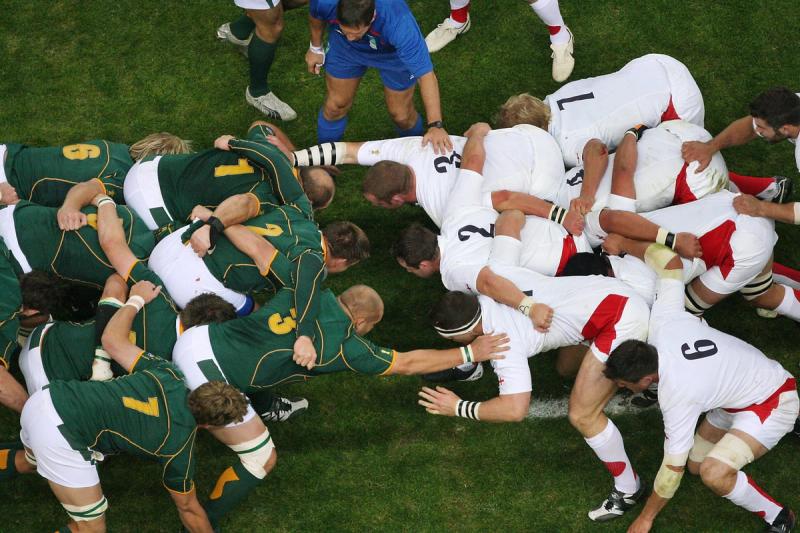Rugby, with its unique blend of physicality and strategy, can seem complex to newcomers. One aspect that often appears perplexing is the scrum and lineout. These set-piece plays are fundamental to the game, offering opportunities for teams to contest possession and gain strategic advantages. In this comprehensive guide, we'll demystify scrums and lineouts, providing newcomers with a clear understanding of these crucial components of rugby.
The Role of Set-Pieces in Rugby
Set-pieces, such as scrums and lineouts, are organized plays that restart the game after certain stoppages. They provide structured opportunities for teams to compete for possession and dictate play. Understanding the dynamics of these set-pieces is vital for players and fans alike.
The Scrum
The scrum is one of the most iconic elements of rugby, involving a contest for the ball between the two teams' forward packs. Here's a step-by-step breakdown of how a scrum works:
Formation:
- In a scrum, the forwards from each team bind together in a specific formation. The front row consists of two props and a hooker, while the second row has two locks. The remaining forwards form the back row.
Engagement:
- The scrum begins with the opposing forward packs binding together, with the front rows interlocking. The referee signals the engagement, and the two teams engage by pushing against each other, aiming to secure possession of the ball.
Feeding the Ball:
- The scrum-half, a backline player from the team not in possession of the ball, feeds the ball into the scrum. It's crucial for the feed to be straight down the middle to maintain fairness.
Hooker's Role:
- The hooker, from the team in possession, attempts to hook the ball back to their teammates' feet. This is a crucial skill and requires precision.
Opposition's Effort:
- The opposing forward pack endeavors to disrupt the scrum and either secure possession or prevent the attacking team from gaining an advantage.
Winning or Losing the Scrum:
- A scrum can be won or lost, with the team that prevails gaining a significant advantage in terms of field position and possession.
The Lineout
The lineout is another vital set-piece in rugby. It is used to restart play when the ball goes out of bounds. Here's how a lineout operates:
Formation:
- Players from both teams lift their teammates to compete for the ball, which is thrown in by a designated player from the team that didn't touch the ball last.
Throwing in the Ball:
- The throwing team's hooker typically throws the ball into the lineout. The thrower aims to target a jumper from their team.
Contested Play:
- Lineouts are often contested by both teams, with players attempting to catch the thrown ball and secure possession.
Winning the Lineout:
- Winning a lineout provides a strategic advantage in terms of possession and field position, as it allows the team to regain control and initiate an attack.
The Purpose of Set-Pieces
Scrums and lineouts serve various purposes in rugby, enhancing the strategic depth of the game. Here are some key roles they play:
Regaining Possession:
- Both scrums and lineouts are opportunities for a team to regain possession of the ball. Winning a scrum or lineout allows the team to control play and advance toward the opponent's try line.
Field Position:
- Successful set-pieces can provide a team with favorable field position, enabling them to attack or defend effectively. A lineout, for example, can be used strategically to gain territory.
Restarting Play:
- When the ball goes out of bounds or there's a stoppage in play, scrums and lineouts serve as a means to restart the game. This keeps the action flowing and maintains the continuity of the match.
Strategic Play:
- Set-pieces offer opportunities for teams to execute planned plays and strategies. Specific lineout and scrum plays can be designed to exploit the weaknesses of the opposing team.
The Scrum: A Closer Look
The scrum is a unique and highly regulated aspect of rugby. It is a contest that involves the forward packs of both teams, and it adheres to specific rules and procedures to ensure fairness. Let's explore the scrum in more detail:
Formation and Positioning:
- The scrum comprises eight players from each team, forming three rows. In the front row, the two props (jersey numbers 1 and 3) flank the hooker (number 2) on either side. The second row consists of two locks (numbers 4 and 5). The remaining forwards make up the back row.
Scrum Engagement:
- The scrum begins with the opposing forward packs coming together and binding. The front rows interlock, and the rest of the forwards bind together.
Scrum-Half Feed:
- The scrum-half, usually a backline player, feeds the ball into the scrum by rolling it down the middle channel.
Hooker's Skill:
- The hooker's primary task is to strike the ball back with their foot, often referred to as "hooking" the ball. This action aims to get the ball to the feet of their teammates at the back of the scrum.
Opposition's Effort:
- The opposing forward pack attempts to counter the scrum, either by pushing their opponents off the ball or by disrupting the scrum. This contest can be intense and highly physical.
Winning or Losing the Scrum:
- A scrum can result in various outcomes. The team that prevails can either retain possession and set up an attacking platform, or they may opt to secure quick ball for the backs. Losing the scrum means the opposing team gains possession, potentially in a favorable position.
The Lineout: A Closer Look
The lineout is another intriguing set-piece in rugby, and it involves a high level of skill and coordination. Let's delve deeper into the mechanics of a lineout:
Formation and Positioning:
- Players from both teams gather in a lineout, with jumpers and lifters forming the primary structure. The throwing team designates a player as the thrower (often the hooker), and their task is to throw the ball into the lineout.
Throwing in the Ball:
- The lineout begins when the designated thrower throws the ball down the middle channel of the lineout. The thrower's aim is to target one of their teammates who will jump and catch the ball.
Contested Play:
- Lineouts are often contested by both teams. Players from the opposing team jump to contest the ball, attempting to disrupt the catching team's plans.
Winning the Lineout:
- Successfully winning a lineout provides a team with a significant advantage. They regain possession and can set up their attack, launch mauls, or distribute the ball to their backs to advance.
The Lineout Variations
Lineouts offer various possibilities, and different variations can be employed to suit a team's tactics and strategy. These include:
Quick Throws:
- In certain situations, a team may opt for a quick throw, where the ball is thrown back into play immediately to catch the opposition off guard.
Short Throws:
- Short throws target jumpers who are positioned close to the thrower. This can create opportunities for quick ball distribution and close-range attacks.
Long Throws:
- Long throws aim to reach jumpers positioned deeper in the lineout. This can be used to gain territory or set up attacking plays.
The Importance of Set-Piece Mastery
Mastery of scrums and lineouts is vital for teams looking to excel in rugby. The ability to win scrums and lineouts consistently provides valuable possession and control over the game. Effective set-piece play is often associated with successful rugby teams, as it enables them to dictate the pace and direction of the match.
Common Strategies and Plays
Rugby teams develop various strategies and plays to maximize the impact of set-pieces. These tactics often involve complex movements and coordinated efforts to outwit the opposition. Here are a few common set-piece plays:
Scrum Plays:
- Teams may employ specific scrum plays to exploit weaknesses in the opposing forward pack. This might involve a planned move with the aim of getting the ball to a fast backline player or creating an overload in one direction.
Lineout Plays:
- Lineout plays can be designed to deceive the opposition and create opportunities for a surprise attack. They may involve fake jumps, quick throws, or intricate moves that confuse the defense.
Set-Piece Combinations:
- Often, teams use set-piece combinations that involve both scrums and lineouts. These combinations aim to keep the opposition guessing and create strategic advantages.
Set-Pieces and the Evolution of Rugby
The art of scrums and lineouts adds depth and intrigue to rugby. They test the physical prowess and tactical acumen of both teams and have evolved significantly over the years. Rules and regulations are continually refined to ensure player safety and a fair contest for the ball.
Conclusion
Rugby's scrums and lineouts may appear complex, but they are essential aspects of the game that provide opportunities for teams to gain possession, advance on the field, and execute planned plays. Understanding the mechanics of these set-pieces is crucial for players and fans, as it deepens the appreciation of the strategy, skill, and teamwork involved in the sport. Whether you're watching a thrilling match or stepping onto the field yourself, the mastery of scrums and lineouts remains a fundamental element of the exhilarating world of rugby.
Related posts
See all
February 23rd
The Evolution of Rugby Tactics: Top 5 Innovations That Changed the Game
Discover the dynamic evolution of rugby tactics through the top 5 innovations that reshaped the game. From the introduction of set plays to the embrace of data analytics, rugby's strategic landscape has evolved dramatically. These innovations reflect a relentless pursuit of excellence and a commitm...

February 20th
Total Rugby: Embracing the Essence of Dynamic Play
Total Rugby, born from Fred Allen's vision, revolutionized rugby with its fluidity and creativity. Encouraging unstructured play, it empowered players to adapt and express themselves freely on the field. Its legacy extends globally, inspiring teams to embrace versatility and innovation. Total Rugby ...

January 4th
Triple Crown Triumph: Rugby's Prestigious Trophy
The Triple Crown, steeped in rugby lore, transcends sport as a symbol of excellence and national pride. From its origins in the late 19th century to the modern era's dynamic clashes.

November 19th
Evolution of Rugby: From Inception to Modern-day Mastery
Unveil the evolution, triumphs, and challenges that define rugby's unparalleled journey—a testament to the enduring spirit that has shaped it into a worldwide phenomenon.

November 9th
Scrums and Lineouts Demystified: Rugby Basics
Rugby's scrums and lineouts, often seen as intricate components, are pivotal in the sport's dynamics.

November 6th
Rugby Basics: A Step-by-Step Guide to Scoring a Try
Scoring a try in rugby is a thrilling culmination of teamwork, strategy, and skill. It involves grounding the ball with downward pressure in the opponent's in-goal area, worth five points.